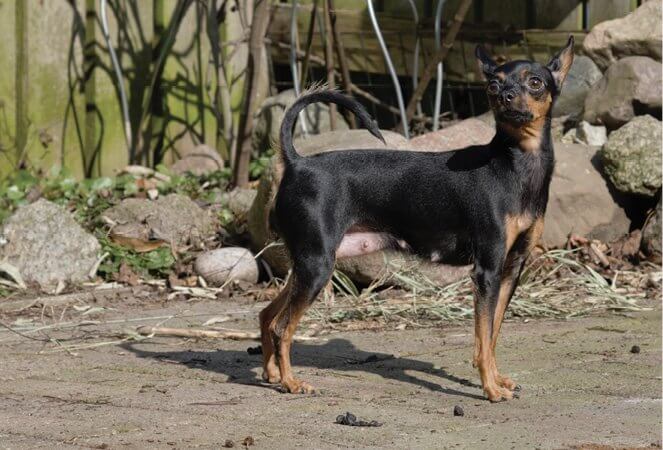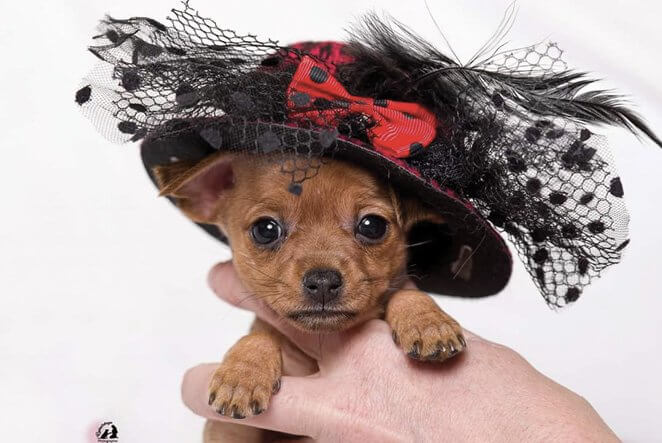
Home » Smooth and Long – Coat Types of the Russian Toy Dog

Smooth and Long – Coat Types of the Russian Toy Dog
The Russian Toy comes in two different coat types; however, the long coat type is more frequently seen in the United States. What some people may be surprised to know is that the smooth coat variety was the original coat of the Russian Toys. In the 18th century, the English Toy Terrier was popular among the Russian socialites, and in the 20th century, the breed had grown considerably, and they began to be referred to as the Russian Toy Terrier. Numbers decreased significantly between 1920 and 1950, but Russian breeders then started reviving the breed. In 1958, the two smooth coat parents with slightly longer coats gave birth to a long coat dog, and the Russians decided to keep this variety and began breeding for it as well. The long coat variety was originally known as the Moscow Long Hair Toy Terrier, but in the 1980s the breeds were merged and became the Russian Toy, which comes in the two coats that we see today.
The structure of both coat varieties should be the same as described in the standard for the Russian Toy, with the key proportions of: the length of the body should be equal to the height at the withers; the height at the elbow is only slightly more than half the height at the withers; and the length of the muzzle is shorter than the length of the skull. Essentially, if you shaved a long coat Russian Toy and placed it next to a smooth coat dog, you should be looking at the same silhouette. While some people have described a difference in temperament between the two coats, this is not found in the standard or my personal experience. Smooth coats and long coats fall along the spectrum of temperament for the Russian Toy and there is not a difference between the coats when you consider the breed as a whole instead of just individuals. All Russian Toys should have the same active, cheerful, intelligent temperament without being cowardly or aggressive.

The difference described in the AKC standard is all about the coat of the dogs and a few items which are affected by the coat. There is only one disqualification that is coat-specific in the AKC standard, and this involves the ears, where long coat dogs cannot have the absence of fringe on the ears or curly hair. In the FCI standard (country of origin), there are three additional disqualifications that are mentioned, which are semi-pricked ears in smooth coat dogs, drop ears in long coat dogs, and on smooth coat dogs numerous bald patches (more than 25%) or very soft, tousled, loose body hair with pronounced feathering. A trimmed coat on either variety is also a DQ in the FCI standard, and this item as well as the others are described in the AKC standard but not stated explicitly in the DQ section. There are two additional coat-related items that are described outside of the coat section of the standard, and the first is that semi-pricked ears are permissible on long-haired dogs with heavy fringe (but are not desirable). While the AKC standard does not specifically discuss the smooth coat ears, the FCI does state that soft ears in a smooth coat is a fault as well. The second item is called out in the color section, and faults the presence of bald patches in smooth coat dogs and too long or short hair on the body of long coat dogs. So, when viewing a mixed-coat group of Russian Toys, it is most important to be aware of what the correct coat is for each variety; and beyond that, they can be judged together.

The smooth coat dogs should have short, close lying, shiny hair without bald patches or undercoat. The correct coat is similar to the coat of the Toy Manchester Terrier or the Min Pin, and is different than the Chihuahua coat, which is usually thicker on smooth coat dogs. The simple beauty of the smooth coat variety allows a good view of the dog’s structure and muscle, and makes it very easy to see any faults. The coat does not require any lengthy grooming or trimming (though trimming is alsonot allowed in the long either) and does not need to be blown dry after bathing. The smooth coat can be more susceptible to cold and tends to be more interested in wearing a sweater or remaining inside during the winter. Overall, it is a very easy coat to care for and is an option for an owner who wants a low maintenance coat.

The long coat is described in more detail in the standard and starts with stating that the body hair should be moderately long (one to three inches) and straight or slightly wavy. The body hair should be close-lying and not hide the natural outline of the body, so one should still be able to assess the structure and proportions of the dog. The hair on the head and front part of the limbs is close-lying, while there are feathers on the back of the limbs, and the feet have long, silky hair that completely covers the nails. This describes a coat with distinct long and shorter, smooth portions where theoutline of the body is visible and the body hair is not tousled but rather close-lying. Finally, the standard describes the ears which are to be covered with long, thick hair forming a fringe and should be long enough to completely hide the outer edge and tips of the ears by the time the dog is three years old. While it is not specifically mentioned in the AKC standard, the tail should also have distinct feathering on the long coat dog. While the long coat Russian Toy does require more grooming than the smooth coat, it is still a more low maintenance coat and trimming should not be necessary (and is a DQ in the FCI standard). These dogs will require drying time after a bath, unlike their smooth counterparts, and I have observed that they are more tolerant of cool temperatures.

Personally, I own dogs of both coat varieties and have trained and shown both coats. I enjoy the flowing ear and tail fringe on my long coats, but it is also nice to not have the worry about tangles on the smooth coats as they are quite active little dogs. I enjoy the shiny coat of the smooth variety and how well it shows off the square silhouette of the breed. I do look forward to seeing more smooth coat Russian Toys in the show ring and hope that the coat varieties will become more equally shown in the United States. Above all, I enjoy the companionship and intelligence of the breed, and the fact that they are good partners in the conformation ring, performance sports, or even just as a pet at home.
Smooth and Long – Coat Types of the Russian Toy Dog
By Jennifer Grebinoski
